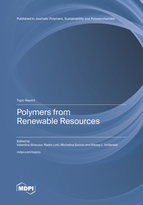Topic Menu
► Topic MenuTopic Editors




Polymers from Renewable Resources

A printed edition is available here.
Topic Information
Dear Colleagues,
The Food and Agriculture Organization of the United Nations (FAO) has estimated that about one-third of the food produced for human consumption is currently lost or wasted, resulted in an estimated approximately USD 750 billion dollars of direct costs for food producers every year. Of course, packaging plays a key role in reducing food waste and in food preservation and protection due to its innovative properties and eminent versatility of applications. Polymers and their composites as packaging plastics have made strong contributions to changing global needs and to the progress of modern technologies. However, plastic packaging is still considered in the framework of the outdated paradigm “make, use, and dispose it”, with great material and energy losses being incurred after a disposable cycle of plastic performance. Consequently, hundreds of millions of tons of plastics are lost from disposal practices and end up in the environment. The most interesting challenge for the future could be the use of food waste as a renewable resource to produce new bio-based and/or biodegradable polymers with well-tailored properties. The circular economy is based on this important and new concept: eliminate waste, rebuild natural capital, and create economic value by using and not consuming resources. This game-changing strategy will include the promotion of sustainable polymer technologies that are able to exclude plastics from fossil resources, use renewable resources obtained from food or natural wastes as principal feedstocks, reduce the presence of plastics in the environment, and increase the quality and uptake of plastic recycling. This purpose of this collection was to cover all topics related to bioplastics obtained from renewable resources, including innovative feedstock, polymerization processes, full characterization, final applications and, of course, life cycle assessment analysis. Both research papers as well as reviews on this topic are welcome, and this collection has the main aim of sharing academic and industrial efforts related to new and innovative sustainable materials and technologies.
Dr. Valentina Siracusa
Prof. Dr. Nadia Lotti
Dr. Michelina Soccio
Prof. Dr. Alexey L. Iordanskii
Topic Editors
Keywords
- biobased polymers
- biobased polyesters
- biodegradable polymers
- sustainable development
- waste-derived materials
- renewable resources
- sustainable packaging
- green composites
- furan-based polymers
- compostable materials
Participating Journals
| Journal Name | Impact Factor | CiteScore | Launched Year | First Decision (median) | APC |
|---|---|---|---|---|---|

Polymers
|
5.0 | 6.6 | 2009 | 13.7 Days | CHF 2700 |

Sustainability
|
3.9 | 5.8 | 2009 | 18.8 Days | CHF 2400 |

Polysaccharides
|
- | - | 2020 | 17.6 Days | CHF 1000 |

MDPI Topics is cooperating with Preprints.org and has built a direct connection between MDPI journals and Preprints.org. Authors are encouraged to enjoy the benefits by posting a preprint at Preprints.org prior to publication:
- Immediately share your ideas ahead of publication and establish your research priority;
- Protect your idea from being stolen with this time-stamped preprint article;
- Enhance the exposure and impact of your research;
- Receive feedback from your peers in advance;
- Have it indexed in Web of Science (Preprint Citation Index), Google Scholar, Crossref, SHARE, PrePubMed, Scilit and Europe PMC.
Related Topic
- Polymers from Renewable Resources, 2nd Volume (4 articles)

